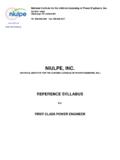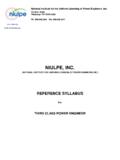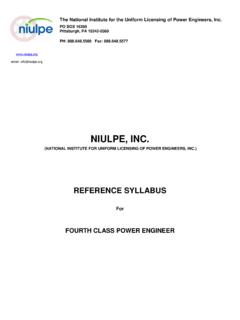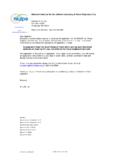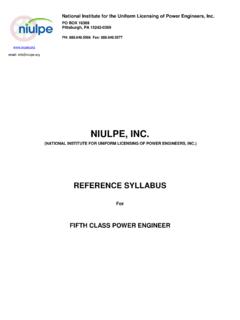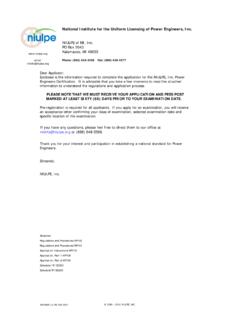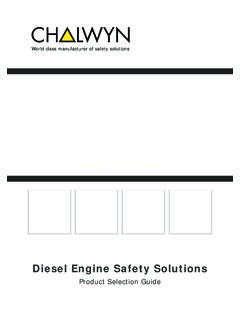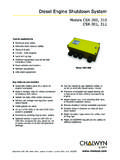Transcription of NIULPE PE 2nd Class R3 091009
1 NIULPE , INC. (NATIONAL INSTITUTE FOR THE UNIFORM LICENSING OF POWER ENGINEERS, INC.) REFERENCE SYLLABUS For SECOND Class POWER ENGINEER National Institute for the Uniform Licensing of Power Engineers, Inc. PO BOX 16369 Pittsburgh, PA 15242-0369 PH: Fax: email: 06-104 R3 09/10/09 2005 2009 NIULPE , INC. Page 2 of 10 Introduction This syllabus has been approved by the NATIONAL INSTITUTE FOR UNIFORM LICENSING OF POWER ENGINEERS, INC. ( NIULPE ) This Syllabus is intended to assist candidates studying for the Second Class Power Engineer Examination. Recommended Study Program: It is recommended that, before undertaking this examination, the candidate completes the Second Class Power Engineering Course offered through a recognized technical institute or training provider.
2 In addition to the foregoing course, it is recommended that the candidate becomes familiar with the publications listed in the Reference Material for Power Engineering Students and Examination Candidates, which is obtainable from the various technical institutes or from the NIULPE Website. 06-104 R3 09/10/09 2005 2009 NIULPE , INC. Page 3 of 10 REFERENCE SYLLABUS FOR SECOND Class EXAMINATION CANDIDATES 1. Code, Sections 1 & 8, Calculations: Design values to be computed for the following boiler and pressure vessel parts: a) Cylindrical components; dished heads; unstayed flat heads, formed heads, shells and covers. b) Openings and compensation: openings in shells, headers and heads; compensation required; strength of compensation, pressure vessel openings and reinforcements.
3 C) Stayed surfaces: dimensions and locations of staybolts, ligaments and braced surfaces. d) Safety valves and safety relief valves: size and capacity. e) Firetube Boilers: i) Combustion chambers and furnaces: plain circular furnaces; circular flues; Adamson ring reinforced and corrugated furnaces. ii) Stayed surfaces: maximum spacing of stays; areas of heads to be stayed; stresses in diagonal stays. 2. Industrial Administration: a) Legislation: a thorough knowledge of the jurisdictional Act and the Regulations under the Act. b) Installations: factors and codes governing plant designs and layouts; contract specifications; working knowledge of the engineering and administration involved in plant erection; practical modifications of existing plant.
4 C) Management: i) Functions and objectives of management. ii) Personnel management: selection of staff; personnel training; motivating personnel; disciplining employees. iii) Planning; decision making; report writing. d) Plant maintenance; inspection; budgeting. e) Safety programs. 3. Applied Mechanics: a) Velocity and acceleration: speed; linear velocity and acceleration; angular velocity and acceleration; relative and absolute velocity. b) Mass, motion and inertia: force of gravity; weight; mass inertia; accelerating force; momentum. c) Work, power and energy: work, graphical representation; indicated and brake horsepower; potential and kinetic energy; conservation of energy; flywheel.
5 D) Torque and angular motion: moment of inertia; radius of gyration; work done by torque; e) Motion in a circular path: centripetal acceleration; centripetal and centrifugal force; balancing of rotating masses; governors. f) Friction: coefficient of friction; frictional force; motion on horizontal and inclined planes; the screw thread; transmission of power by belt drives. 06-104 R3 09/10/09 2005 2009 NIULPE , INC. Page 4 of 10 g) Moments: moments of forces; couple; centroids and second moments of area. h) Stress and strain: modulus of elasticity; restricted expansion. i) Shearing forces and bending moments: sign conventions; conditions of equilibrium; simply supported beams and cantilevers; concentrated and distributed loading; mathematical and graphical solutions for shearing force and bending moment diagrams.
6 J) Torsion: fundamental torsion equation; relationship between torque, stress and horsepower; maximum and mean torque; coupling bolts. k) Pressure of liquids: density; specific gravity; pressure at any depth; centre of pressure; displacement. l) Flow of liquids: pressure head; Bernoulli s law; Venturi meter; flow through orifices. 4. Thermodynamics: a) Heat and measurement of heat: temperature scales; absolute temperature; units of heat and their relationship; specific heat; water equivalent; sensible and latent heat; heat mixtures. b) Expansion of solids and heat transfer: linear, surface and volumetric expansion; conduction, convection and radiation.
7 C) Work and heat: mechanical equivalent of heat; laws of thermo-dynamics; Boyle s and Charles Laws; general gas law; characteristic constant of a gas; specific heats of gases; thermal efficiency. d) Expansion and compression of gases: Dalton s Law of partial pressures, adiabatic, isothermal and polytropic; ratios of expansion and compression; work done during expansion and compression. e) Thermodynamics of steam: steam tables; saturated and superheated steam; dryness fraction; specific volume; specific heat of superheated steam; heat mixtures; throttling and separating calorimeters; internal energy of steam, enthalpy. f) Entropy: entropy of water, evaporation and superheated steam; temperature-entropy diagrams and charts; computations of entropy values.
8 G) Practical Cycles: i) Practical cycles: Rankine; Otto; Diesel; Brayton, thermal efficiencies; pressure-volume and temperature-entropy diagrams. ii) Energy flow calculations; efficiency limits of heat engines, boiler and plant efficiencies, heat balance testing. 5. Metallurgy: a) Non-ferrous metals: properties, composition and uses; copper; brasses; bronzes; aluminum; white metal. b) The structure of metals: atoms; elements; crystalline structure of metals; grains and grain boundaries, metallographic examination. c) Alloying elements in iron; iron-carbon equilibrium diagram; alloy steels; stainless steels and high-chromium alloys; cladding steels.
9 D) Heat treatment of metals: normalizing; annealing; spheroidizing; hardening; tempering; quenching. e) Welding symbols f) Metallurgical applications/specifications to power plant piping and tubing 06-104 R3 09/10/09 2005 2009 NIULPE , INC. Page 5 of 10 6. Testing of Materials: a) Procedures and interpretations affecting tensile, hardness and impact tests; forms of specimens tested. b) Mechanical, physical and thermal properties of ferrous metals: creep resistance, corrosion resistance and fatigue tests. c) Weldment defects: dimensional defects; structural discontinuities; defective properties. d) Nondestructive testing: visual inspection; magnetic particle inspection; liquid penetrant testing; proof tests; leak tests, ultrasonic, radiography, acoustic emission.
10 7. Boilers: a) Steam generator design considerations. b) Methods of heat transfer; circulation; steam generator ratings. c) Specialized boiler designs and applications d) Types and applications of firetube and watertube boilers/steam generators. e) Boiler fittings, including safety devices, drum internals, soot blowers. f) Boiler details: waterwalls; superheaters; desuperheaters; attemperators; heaters; blow-down systems; flash tanks; steam separators. economizers; air g) Methods of installation and support: foundations; settings; methods of tubing; top drum erection; shop and field assembly. h) Insulation: duct and baffle arrangements; boiler casings.
